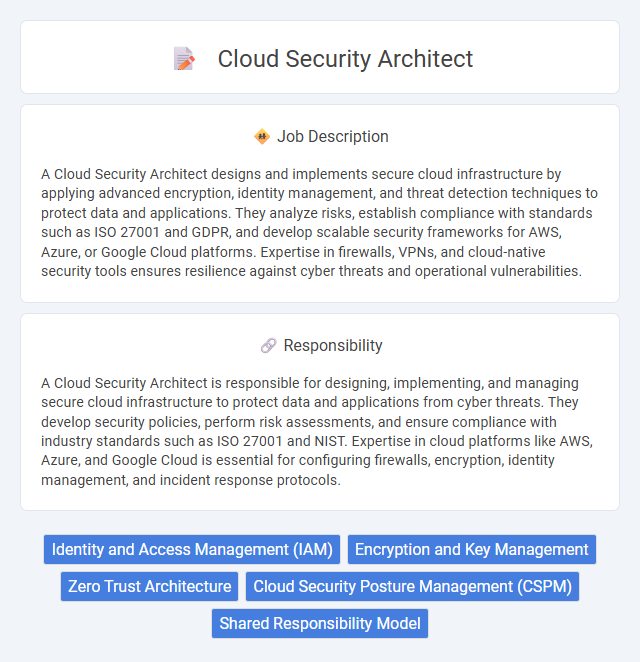
A Cloud Security Architect designs and implements secure cloud infrastructure by applying advanced encryption, identity management, and threat detection techniques to protect data and applications. They analyze risks, establish compliance with standards such as ISO 27001 and GDPR, and develop scalable security frameworks for AWS, Azure, or Google Cloud platforms. Expertise in firewalls, VPNs, and cloud-native security tools ensures resilience against cyber threats and operational vulnerabilities.
Individuals with a strong analytical mindset and a passion for cybersecurity are likely to be well-suited for a Cloud Security Architect role. People who thrive in dynamic environments requiring constant learning and adaptation might find this position fulfilling. Those uncomfortable with high responsibility or continuously evolving technologies may face challenges in meeting the job's demands.
Qualification
A Cloud Security Architect must possess in-depth expertise in cloud platforms such as AWS, Azure, or Google Cloud, combined with certifications like CISSP, CISM, or AWS Certified Security Specialty. Proficiency in designing secure cloud infrastructures, implementing identity and access management (IAM) solutions, and threat modeling is essential. Strong knowledge of compliance frameworks such as HIPAA, GDPR, and NIST, along with skills in encryption, network security, and incident response, are critical qualifications.
Responsibility
A Cloud Security Architect is responsible for designing, implementing, and managing secure cloud infrastructure to protect data and applications from cyber threats. They develop security policies, perform risk assessments, and ensure compliance with industry standards such as ISO 27001 and NIST. Expertise in cloud platforms like AWS, Azure, and Google Cloud is essential for configuring firewalls, encryption, identity management, and incident response protocols.
Benefit
A Cloud Security Architect likely enhances an organization's protection by designing secure cloud infrastructures that reduce risks of data breaches and cyberattacks. This role probably ensures compliance with industry regulations, saving costs related to fines and reputational damage. Employers may benefit from improved system reliability and trust from clients due to their expertise in implementing advanced security measures.
Challenge
A Cloud Security Architect likely faces the challenge of continuously adapting to emerging threats and evolving cloud technologies to ensure robust protection. Balancing scalability and security may require innovative approaches and in-depth knowledge of diverse cloud environments. The probability of navigating complex compliance requirements could add another layer of difficulty to the role.
Career Advancement
A Cloud Security Architect plays a critical role in designing and implementing secure cloud infrastructure, making expertise in cloud platforms like AWS, Azure, and Google Cloud highly valuable for career growth. Mastery of compliance standards such as GDPR, HIPAA, and ISO 27001 enhances job prospects and paves the way for leadership roles in cybersecurity strategy. Advancing in this field often involves obtaining certifications like Certified Cloud Security Professional (CCSP) and expanding skills in DevSecOps and automated security tools.
Key Terms
Identity and Access Management (IAM)
A Cloud Security Architect specializing in Identity and Access Management (IAM) designs and implements robust authentication and authorization frameworks to safeguard cloud environments. Expertise includes configuring role-based access controls (RBAC), integrating multi-factor authentication (MFA), and ensuring compliance with standards like IAM policies across AWS, Azure, or Google Cloud platforms. This role is critical for minimizing security risks by enforcing least privilege access and monitoring identity governance.
Encryption and Key Management
A Cloud Security Architect designs and implements robust encryption strategies to protect sensitive data across cloud environments, ensuring compliance with industry standards such as AES-256 and RSA encryption protocols. They develop comprehensive key management frameworks involving secure key generation, storage, rotation, and access control using tools like AWS KMS, Azure Key Vault, or Google Cloud KMS. Their expertise ensures the confidentiality, integrity, and availability of cryptographic keys, mitigating risks of data breaches and unauthorized access in multi-cloud or hybrid infrastructures.
Zero Trust Architecture
A Cloud Security Architect specializing in Zero Trust Architecture designs and implements security frameworks that assume no implicit trust within or outside the network, focusing on strict identity verification and least-privilege access. This role involves integrating multi-factor authentication, micro-segmentation, and continuous monitoring to protect cloud environments from advanced threats and insider risks. Expertise in cloud platforms such as AWS, Azure, or Google Cloud, combined with knowledge of security protocols like OAuth, SAML, and Zero Trust Network Access (ZTNA), is essential for effective architecture and policy enforcement.
Cloud Security Posture Management (CSPM)
Cloud Security Architects specialize in designing and implementing robust Cloud Security Posture Management (CSPM) strategies that continuously monitor cloud environments for compliance and vulnerabilities. They utilize advanced CSPM tools to automate detection of misconfigurations, enforce security policies, and reduce risks across multi-cloud infrastructures. Their expertise ensures organizations maintain secure cloud deployments while aligning with regulatory standards and industry best practices.
Shared Responsibility Model
A Cloud Security Architect designs and implements robust security frameworks based on the Shared Responsibility Model, clearly defining the division of security duties between cloud service providers and clients. They assess risks, enforce compliance, and deploy advanced encryption and access control measures to protect cloud infrastructure and data. Mastery of provider-specific security tools and continuous monitoring ensures that both parties fulfill their roles to maintain a secure cloud environment.
 kuljobs.com
kuljobs.com